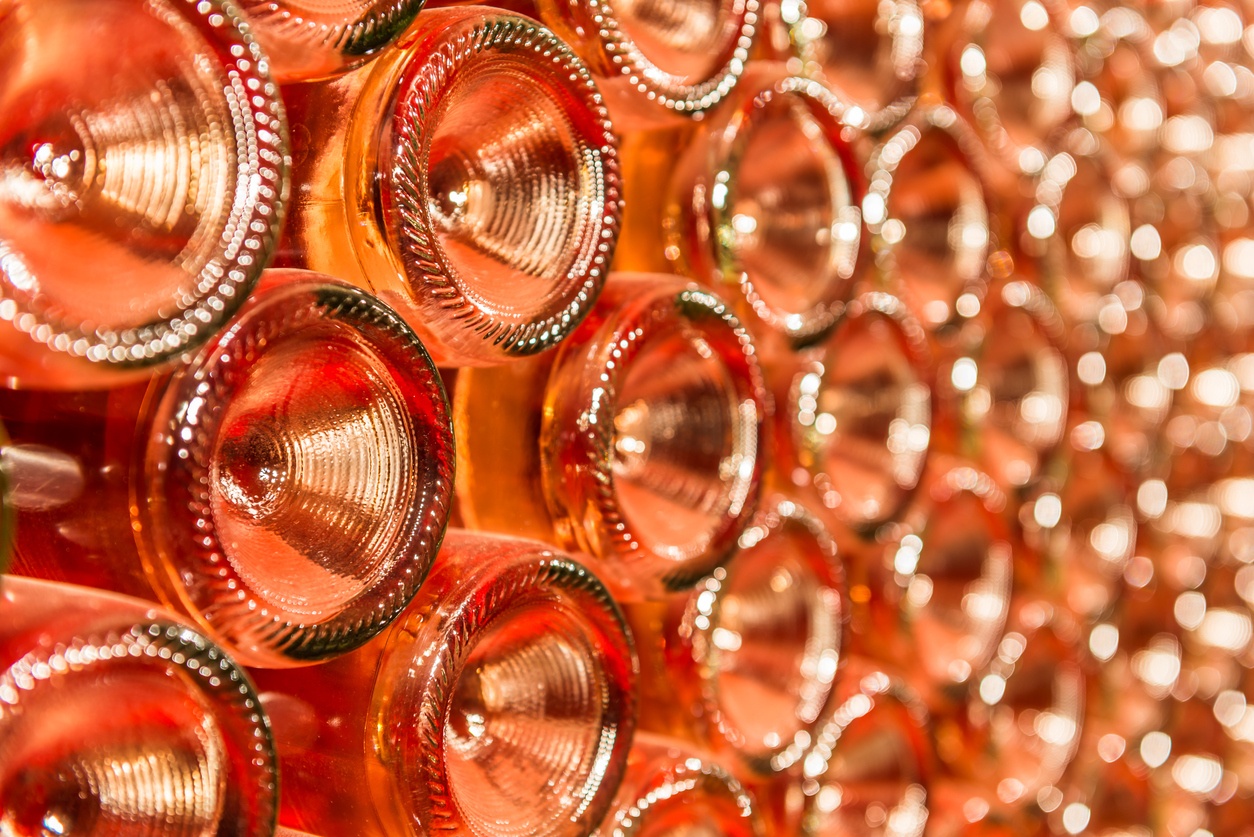This week, we’ve taken 20% off rosés at Oliver’s, and to prepare you for this pink drink bonanza, we’ve put together all the info you never knew you needed on your favorite pink wines! Rosé wines have earned a reputation for drinkability and versatility, and with good reason – this genre of wines is so expansive that you can find the perfect shade of pink no matter what your tastes. With flavor profiles ranging from delicate and fruity to bold and peppery, rosés manage to seamlessly bridge the gap between luxury wines and the average table wine; they can be paired with almost anything, and their crisp, refreshing nature makes them easy to enjoy all day or all night.
Now, some might think that rosés are a recent phenomenon, or that they’re merely another wine fad doomed to inevitable extinction (anyone remember shimmery wine concoctions). In fact, rosés actually have a fairly incredible history stretching all the way back to antiquity, and the wine-making practices used in their creation are as varied as the wines themselves.
Development
To anyone still convinced rosés are a 20th century invention, we have one word: HA! In fact, rosés are one of the oldest styles of winemaking and have a history as deep as the European continent from whence they came. The first records we have of winemaking in the ancient world are of rosé, although it would not have been called that at the time. Pink wine was commonly produced by field blending both red and white grapes during the stomping process. The mixed juice was then placed in a ceramic fermentation vessel known as a pithoi, where it would eventually age into wine. Due to the stems, seeds, and skins being left in the juice for the aging process, the wines produced were slightly off-dry and quite tannic. In Greece, these potentially unpleasant flavors would be minimized by watering the wine – the ancient Greeks believed that it was civilized to water down wine, and they associated the consumption of unwatered wine with barbarian cultures, far beneath the enlightened culture of the Greeks. As a result, most wines were some shade of pink or orange, rather than the deep red we often see depicted in film. In fact, lighter wines dominated ancient wine consumption; though the Greeks and Romans eventually began to separate white and red grapes during the winemaking process, the red wines they produced were so tannic that they were difficult to drink, making lighter wines the preferred alternative.
Eventually, a group of traders known as the Phocaeans brought the world what we now think of as true rosé wine. While expanding their trading route, the Phocaeans stumbled upon a place they dubbed Massalia, known today as the Marseille region of France. They brought with them grape vines from Greece, and they began producing wines with the customary blend of red and white grapes. These pink wines developed a reputation for being particularly pleasant to drink, and after being conquered by the Romans, Marseille became known as the place to be for excellent rosé wine, a title it maintains to this day. By the Middle Ages, rosé had even spread to the British aisles as a drink called claret. Claret was a rosé made of Bordeaux that had developed in the Bordeaux region of France; when Bordeaux was captured by the British, claret was spread to Britain where it achieved something of a cult following until the early 1900’s.
By the 19th century, rosés no longer held the top wine spot in Europe but were still known as drinkable and refreshing wines that were perfect for an afternoon of leisure; meanwhile, they were virtually nonexistent in the US, with the focus instead being given to the production of whites and reds. In 1869, George West of El Pinal Winery in Lodi, California created the first recorded White Zinfandel in US history; the wine he created was deemed impressive enough by the viticultural commissioner that he began to advocate for the use of Zinfandel outside of red wines, but despite his best efforts, White Zinfandel gained no traction and was eventually set aside. Rosé hit further speedbumps in the US thanks to brands such as Mateus and Lancer. Both were off-dry, Portuguese rosés that became known as cheap to buy, cloyingly sweet to drink, and the source of an unending number of hangovers on the part of those who consumed them. Nevertheless, these wines achieved a certain amount of popularity in the US, and as a result, the reputation of rosé in the states was not that of a “serious” wine.
Rosé maintained this sorry rep all the way until the early 2000’s, when the importation of French rosés finally began to mend the damage of Mateus and their ilk. Suddenly, Americans were being exposed to complex rosés that challenged all previously held notions of what rosé could be. A market for high quality, American-made rosé wines began to develop, and wineries across the country began to add rosés to their wine lineup to satisfy growing demand. Popularity grew and grew until finally, finally we arrived at where we are today: a remarkably diverse and brilliantly crafted selection of rosés, each bearing the distinct signature of the winemaker who produced it!
Making Rosés Today
We’ve come a long way from those initial hodge-podge blends of red and white grapes, and modern rosé production is an art as much as a science. Currently, there are four main methods used by winemakers to produce commercial rosés. Each method lends a distinct character to the wine it produces, and each winemaker in turn can modify the method to suit their particular vision for the wine being made. While you almost never see the method of production listed on a rosé bottle, knowing can definitely give you a leg up when it comes to what to expect from a wine. As with its ancient forebears, a lot of the differences in rosés can be boiled down to how long the juice was exposed to the skins, stems, and seeds before fermentation. This difference in exposure affects everything from the color of the wine – rosés range from the palest salmon pink to ruby red and everything in between – to the balance of the flavors, especially any tannic qualities. Let’s break it all down!
Limited Skin Maceration
Sounds fancy, right? All this really means is allowing the skins to soak in the juice for a certain amount of time. It’s essentially the same process as the method used for preparing red wine, the main difference being that, while red wines may sit with their skins for several weeks if not months, rosés will be left for only a matter of hours. The longer the skins are left, the more red wine qualities the rosé will exhibit in the finished wine, such as darker notes and a fuller body. When fermentation is ready to begin, the juice is drawn off the skins in a process called racking. This method is hugely versatile, and a winemaker can produce a vast range of rosés simply through limited skin maceration alone.
Direct Pressing
Just as limited skin maceration is also used to produce reds, direct pressing is used to produce whites as well as rosés. The red grapes are mashed and then quickly pressed; while the skins never soak in the juice the way they would with limited skin maceration, some pigment inevitably manages to tint the juice. This process creates rosés that are wonderfully light in both color and flavor, notable for their luxuriously light body and delicate notes of fresh berries and citrus. Of course, a great deal of flavor comes down to the grapes that are actually being used, but the point still stands – direct pressing is a great way to produce light rosés.
Saignée Method
Literally translated as “bleeding”, the saignée method doesn’t actually involved blood – we promise! Rather, a small amount of juice is “bled” or siphoned out of a batch destined to become red wine. This serves two purposes: first, it helps to concentrate the red wine being made, resulting in a more complex and interesting finished product. The second is that allows the rosé to take on a shadow of the characteristics of the parent red, making for a rosé that is rich in style and deep in flavor. Unfortunately, winemakers will occasionally see the rosé produced by this method as a way of using unwanted biproduct, and the wines produced will lack the substance of other rosés. However, when treated correctly, saignée method rosés can be truly impressive to behold.
Blending
There is a common misconception that rosés are all a blend of red and white wines, but the reality couldn’t be more different! In Europe, blending wines post-fermentation is entirely prohibited, with the one exception being the production of champagnes. In that case, blending is actually encouraged, as it is believed to produce a superior quality of sparkling rosé. In the US and other “New World” countries where winemaking practices are less rigid, blending is not overly common, but you do see the occasional winery who will produce a blended rosé. As with the other methods, blending can be used to produce a wide variety of rosés, some heavier and some lighter.
Rosés may have taken the wine world by storm over the past decade, but it’s important to realize that these blushing beauties aren’t just the latest fad – rosé wines have some serious staying power! Over the years, they’ve gotten more diverse and more sophisticated, but the appeal of rosé is the same as it’s always been: a light, highly drinkable wine that is as malleable as the people making it are creative. This week, stop into Oliver’s and enjoy 20% off our entire collection of rosés, and experience la vie en rose!


No comments yet. Add the first comment